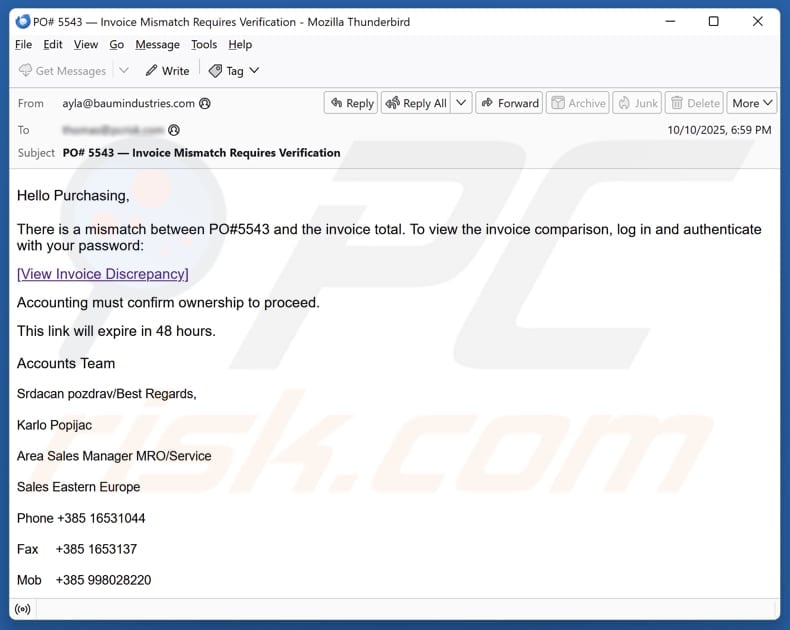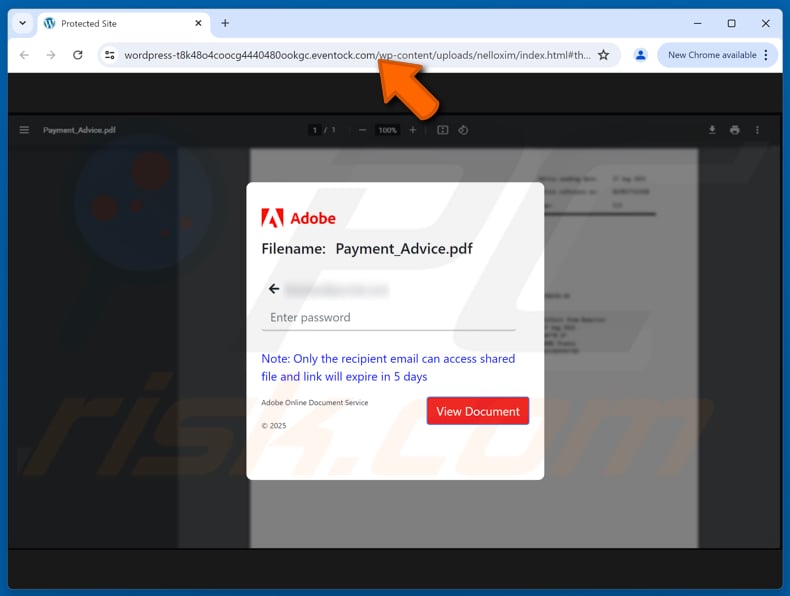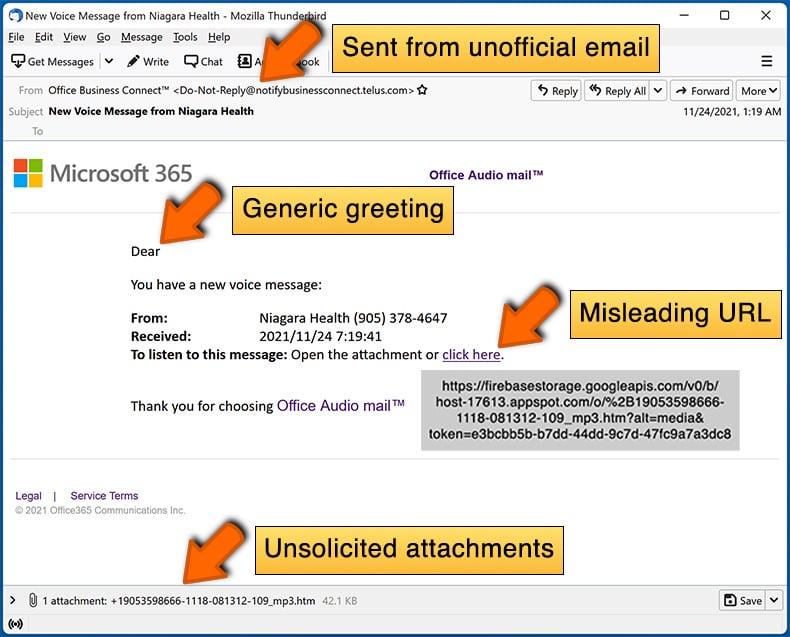How to identify scams like "Mismatch Between Purchase Order And Invoice"
Phishing/ScamAlso Known As: Mismatch Between Purchase Order And Invoice phishing email
Get free scan and check if your device is infected.
Remove it nowTo use full-featured product, you have to purchase a license for Combo Cleaner. Seven days free trial available. Combo Cleaner is owned and operated by RCS LT, the parent company of PCRisk.com.
What is "Mismatch Between Purchase Order And Invoice"?
We have analyzed the email and found that it includes a fake message regarding a mismatch between the purchase order and the invoice. It is designed to trick recipients into taking immediate action, such as clicking on a malicious link, and disclosing sensitive information. This scam email should be ignored.

More about the "Mismatch Between Purchase Order And Invoice" scam email
This email claims there is a mismatch between a purchase order and the invoice total and instructs the recipient to log in and verify their password to view the difference. It warns that the link will expire in 48 hours and highlights that accounting must confirm ownership to proceed.
The message appears to come from a sales manager and includes contact details to make it seem legitimate, but it is designed to trick recipients into providing login credentials. The link ("View Invoice Discrepancy") in this email leads to a fake document ("Payment_Advice.pdf") displayed by a deceptive page.
This fraudulent site claims that only the recipient of the email can access the shared file and that the link will expire in five days. It also instructs users to enter a password to "view document". Any entered passwords are sent to scammers.
Scammers can use stolen passwords to gain access to email, social media, banking, gaming, or other online accounts. Once they have access, they can steal personal information, send phishing emails or malware, carry out fraudulent transactions, or sell the stolen information to others. For these reasons, suspicious emails should be carefully reviewed before clicking links or sharing any personal information.
| Name | Mismatch Between Purchase Order And Invoice Email Scam |
| Threat Type | Phishing, Scam, Social Engineering, Fraud |
| Fake Claim | There is a mismatch between a purchase order and the invoice total |
| Disguise | A message regarding invoice verification |
| Related Domain | eventock[.]com |
| Detection Names (eventock[.]com) | Abusix (Spam), alphaMountain.ai (Suspicious), CyRadar (Phishing), Fortinet (Phishing), Seclookup (Malicious), Full List Of Detections (VirusTotal) |
| Symptoms | Unauthorized online purchases, changed online account passwords, identity theft, illegal access of the computer. |
| Distribution methods | Deceptive emails, rogue online pop-up ads, search engine poisoning techniques, misspelled domains. |
| Damage | Loss of sensitive private information, monetary loss, identity theft. |
| Malware Removal (Windows) |
To eliminate possible malware infections, scan your computer with legitimate antivirus software. Our security researchers recommend using Combo Cleaner. Download Combo CleanerTo use full-featured product, you have to purchase a license for Combo Cleaner. 7 days free trial available. Combo Cleaner is owned and operated by RCS LT, the parent company of PCRisk.com. |
Similar scam emails in general
Emails of this type are generally known as phishing emails. They attempt to deceive recipients by appearing legitimate and urgent, often impersonating trusted organizations or companies. The goal is usually to trick users into revealing sensitive information, such as login credentials or financial details. Recipients are advised to be cautious when receiving such emails.
Sometimes, emails of this type can be used to trick recipients into executing malware on their devices. More examples of scam emails are "Adobe Acrobat Sign Request", "Review Your Recent Activity", "Salary & Performance Award", and "DocuSign - Project Proposal & Quantity Confirmation".
How do spam campaigns infect computers?
Cybercriminals commonly attach infected files such as executables, Office documents, PDFs, scripts, or compressed formats like ZIP and RAR to deliver malware via email. Opening these attachments or enabling features like macros can lead to device infection.
Deceptive emails can also include links to fraudulent or compromised websites that either initiate malware downloads automatically or trick users into downloading and running harmful files or software. In every scenario, malware infection depends on the user interacting with the email's content.
How to avoid installation of malware?
Do not open files or click links in emails or messages from unknown addresses, especially if they are irrelevant or unexpected. Download software from trusted sources, such as official websites or app stores. Avoid allowing suspicious sites to show notifications and do not interact with ads, pop-ups, or similar elements on them.
Also, keep your operating system and security software up to date, and perform regular system scans to detect potential threats.
Text presented in the "Mismatch Between Purchase Order And Invoice" email letter:
Subject: PO# 5543 — Invoice Mismatch Requires Verification
Hello -,
There is a mismatch between PO#5543 and the invoice total. To view the invoice comparison, log in and authenticate with your password:
[View Invoice Discrepancy]
Accounting must confirm ownership to proceed.
This link will expire in 48 hours.
Accounts Team
Srdacan pozdrav/Best Regards,
Karlo Popijac
Area Sales Manager MRO/Service
Sales Eastern Europe
Phone +385 16531044
Fax +385 1653137
Mob +385 998028220
Fake document on a deceptive site used in this scam:

Instant automatic malware removal:
Manual threat removal might be a lengthy and complicated process that requires advanced IT skills. Combo Cleaner is a professional automatic malware removal tool that is recommended to get rid of malware. Download it by clicking the button below:
DOWNLOAD Combo CleanerBy downloading any software listed on this website you agree to our Privacy Policy and Terms of Use. To use full-featured product, you have to purchase a license for Combo Cleaner. 7 days free trial available. Combo Cleaner is owned and operated by RCS LT, the parent company of PCRisk.com.
Quick menu:
- What is Mismatch Between Purchase Order And Invoice phishing email?
- Types of malicious emails.
- How to spot a malicious email?
- What to do if you fell for an email scam?
Types of malicious emails:
![]() Phishing Emails
Phishing Emails
Most commonly, cybercriminals use deceptive emails to trick Internet users into giving away their sensitive private information, for example, login information for various online services, email accounts, or online banking information.
Such attacks are called phishing. In a phishing attack, cybercriminals usually send an email message with some popular service logo (for example, Microsoft, DHL, Amazon, Netflix), create urgency (wrong shipping address, expired password, etc.), and place a link which they hope their potential victims will click on.
After clicking the link presented in such email message, victims are redirected to a fake website that looks identical or extremely similar to the original one. Victims are then asked to enter their password, credit card details, or some other information that gets stolen by cybercriminals.
![]() Emails with Malicious Attachments
Emails with Malicious Attachments
Another popular attack vector is email spam with malicious attachments that infect users' computers with malware. Malicious attachments usually carry trojans that are capable of stealing passwords, banking information, and other sensitive information.
In such attacks, cybercriminals' main goal is to trick their potential victims into opening an infected email attachment. To achieve this goal, email messages usually talk about recently received invoices, faxes, or voice messages.
If a potential victim falls for the lure and opens the attachment, their computers get infected, and cybercriminals can collect a lot of sensitive information.
While it's a more complicated method to steal personal information (spam filters and antivirus programs usually detect such attempts), if successful, cybercriminals can get a much wider array of data and can collect information for a long period of time.
![]() Sextortion Emails
Sextortion Emails
This is a type of phishing. In this case, users receive an email claiming that a cybercriminal could access the webcam of the potential victim and has a video recording of one's masturbation.
To get rid of the video, victims are asked to pay a ransom (usually using Bitcoin or another cryptocurrency). Nevertheless, all of these claims are false - users who receive such emails should ignore and delete them.
How to spot a malicious email?
While cyber criminals try to make their lure emails look trustworthy, here are some things that you should look for when trying to spot a phishing email:
- Check the sender's ("from") email address: Hover your mouse over the "from" address and check if it's legitimate. For example, if you received an email from Microsoft, be sure to check if the email address is @microsoft.com and not something suspicious like @m1crosoft.com, @microsfot.com, @account-security-noreply.com, etc.
- Check for generic greetings: If the greeting in the email is "Dear user", "Dear @youremail.com", "Dear valued customer", this should raise suspiciousness. Most commonly, companies call you by your name. Lack of this information could signal a phishing attempt.
- Check the links in the email: Hover your mouse over the link presented in the email, if the link that appears seems suspicious, don't click it. For example, if you received an email from Microsoft and the link in the email shows that it will go to firebasestorage.googleapis.com/v0... you shouldn't trust it. It's best not to click any links in the emails but to visit the company website that sent you the email in the first place.
- Don't blindly trust email attachments: Most commonly, legitimate companies will ask you to log in to their website and to view any documents there; if you received an email with an attachment, it's a good idea to scan it with an antivirus application. Infected email attachments are a common attack vector used by cybercriminals.
To minimise the risk of opening phishing and malicious emails we recommend using Combo Cleaner Antivirus for Windows.
Example of a spam email:

What to do if you fell for an email scam?
- If you clicked on a link in a phishing email and entered your password - be sure to change your password as soon as possible. Usually, cybercriminals collect stolen credentials and then sell them to other groups that use them for malicious purposes. If you change your password in a timely manner, there's a chance that criminals won't have enough time to do any damage.
- If you entered your credit card information - contact your bank as soon as possible and explain the situation. There's a good chance that you will need to cancel your compromised credit card and get a new one.
- If you see any signs of identity theft - you should immediately contact the Federal Trade Commission. This institution will collect information about your situation and create a personal recovery plan.
- If you opened a malicious attachment - your computer is probably infected, you should scan it with a reputable antivirus application. For this purpose, we recommend using Combo Cleaner Antivirus for Windows.
- Help other Internet users - report phishing emails to Anti-Phishing Working Group, FBI’s Internet Crime Complaint Center, National Fraud Information Center and U.S. Department of Justice.
Frequently Asked Questions (FAQ)
Why did I receive this email?
Scammers often send their fraudulent emails to large groups of people using addresses collected from data breaches, fake websites, or other sources. These messages are generally generic and not aimed at specific individuals.
I have provided my personal information when tricked by this email, what should I do?
Update all passwords that may have been compromised immediately. If any banking details, identification information, or other sensitive information is at risk, notify your bank and the appropriate authorities.
I have downloaded and opened a malicious file attached to an email, is my computer infected?
Opening an executable file can immediately compromise a computer, while malicious documents typically require extra actions, such as enabling macros, to pose a threat. The risk of infection depends on the type of file opened.
I have read the email but did not open the attachment, is my computer infected?
Opening an email alone does not harm a device. Malware can only affect the system if the user opens a malicious attachment or clicks on a dangerous link.
Will Combo Cleaner remove malware infections that were present in email attachment?
Combo Cleaner can remove most malware, but performing a full system scan is recommended to detect any hidden and more advanced threats.
Share:

Tomas Meskauskas
Expert security researcher, professional malware analyst
I am passionate about computer security and technology. I have an experience of over 10 years working in various companies related to computer technical issue solving and Internet security. I have been working as an author and editor for pcrisk.com since 2010. Follow me on Twitter and LinkedIn to stay informed about the latest online security threats.
PCrisk security portal is brought by a company RCS LT.
Joined forces of security researchers help educate computer users about the latest online security threats. More information about the company RCS LT.
Our malware removal guides are free. However, if you want to support us you can send us a donation.
DonatePCrisk security portal is brought by a company RCS LT.
Joined forces of security researchers help educate computer users about the latest online security threats. More information about the company RCS LT.
Our malware removal guides are free. However, if you want to support us you can send us a donation.
Donate
▼ Show Discussion